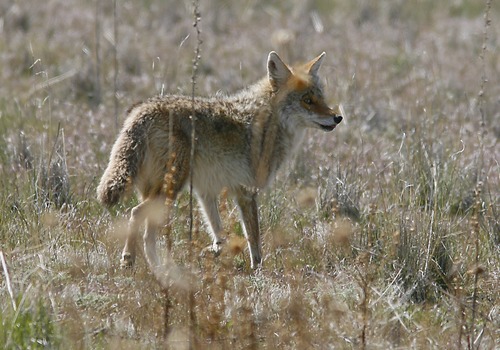This is an archived article that was published on sltrib.com in 2013, and information in the article may be outdated. It is provided only for personal research purposes and may not be reprinted.
Bounty hunters did not kill the number of coyotes that some had hoped during the first year of the Mule Deer Protection Act, but biologists and supporters of the controversial program say it will take time to see if it is helping Utah's herds.
While promoting the act that increased an existing bounty on dead coyotes from $20 to $50, supporters such as Sen. Ralph Okerlund, R-Monroe, and Don Peay, founder of Sportsmen for Fish and Wildlife, often said it would lead to at least 20,000 predators turned in for the cash.
Results of the first year — July 1, 2012, to June 30, 2013 — compiled by the Utah Division of Wildlife Resources show 7,160 were turned in and $380,950 was awarded in bounties. Three contractors were also hired to eliminate coyotes in areas where deer herds appear to be in the greatest decline. Those contractors were paid $45,000.
Okerlund sponsored the bill during the 2012 Legislature. He is disappointed that more coyotes were not killed but said those taken have made a difference, and not only on deer.
"I've talked to people from the Utah Wool Growers Association and they said they have never had a better year with fewer losses than they did this year," Okerlund said. "People are also telling me they are seeing more [deer] twins and a better fawn crop. People are encouraged."
The report said the act may have persuaded 615 new trappers or hunters to kill coyotes. Sixty-seven percent of the coyotes were shot, and 75 percent of all coyotes submitted during the first year were killed in February.
Critics of the Mule Deer Preservation Act have often pointed to the fact that most coyote hunting is done in the winter and not during the fawning season.
"Only 844 (13 percent) of the coyotes were killed on these summer ranges," the report reads. "There are many possible reasons for the low coyote-removal rate in areas important for mule deer production. In any event, these initial data are disappointing, and the Division anticipates the program will be more effective if more coyotes are harvested in summer ranges."
Okerlund said a requirement for hunters to produce the coyote's scalp with two ears, the lower jaw and a data sheet recording where it was killed dissuaded some from turning in animals they shot.
"I talked to people who killed coyotes and didn't bring them in for reimbursement because of the difficulty of the process," Okerlund said. "That might be something we [will] consider changing."
Many participants turned in only one coyote and only 6 percent turned in 25 or more animals. Box Elder County saw the most significant number of animals turned in — 1,142. The report also said 37 percent of the coyotes "were removed from only three deer hunt units: Box Elder, West Desert and Fillmore."
John Shivik, mammals coordinator for the Utah Division of Wildlife Resources, said that the "coyote take" in Utah — including fur trapping, removal by U.S. Department of Agriculture and incidental — remains about the same level as in past years.
Opponents of the Mule Deer Preservation Act were glad to hear Okerlund's hope of 20,000 coyotes killed was not reached. They continue to ask whether the program will do anything to help deer populations and whether it should be funded by taxpayers.
"A lot of research we did indicated deer are really not threatened that much by coyotes and that when we start to kill them off they start to breed more," said Carl Arky, a spokesman for the Humane Society of Utah.
He said members are glad there weren't more animals killed. "There are so many questions on whether this is necessary, whether it works and whether taxpayers should be paying for this."
Twitter: @BrettPrettyman



